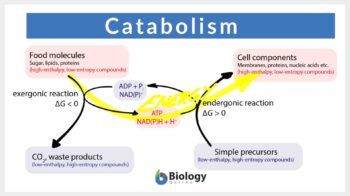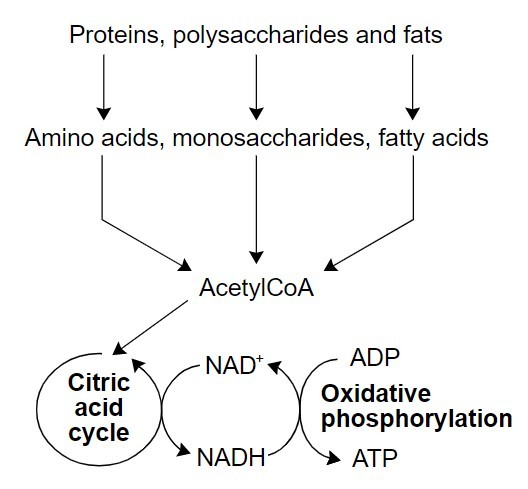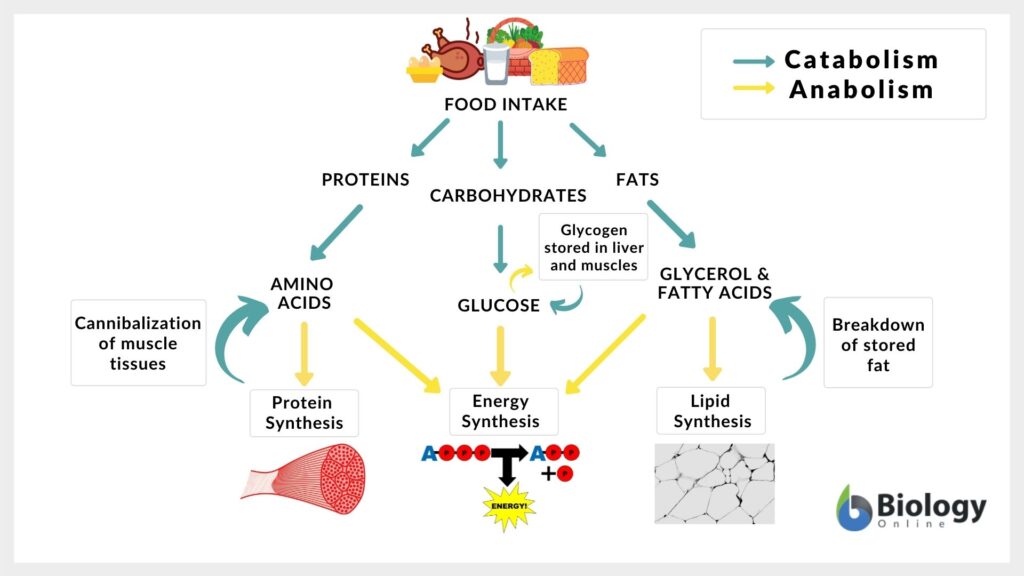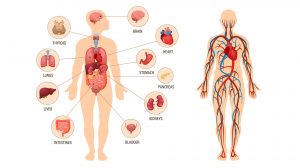
Catabolism
n., [kəˈtæbəˌlɪzəm]
A series of degradative chemical reactions that break down complex molecules into smaller units
Image Credit: Muessig, CC BY-SA 3.0.
Table of Contents
Catabolism Definition
Catabolism is the branch of the metabolic process that breaks down complex, big molecules into smaller ones, yielding energy. It is the destructive branch of the metabolism that results in the release of energy. Each living cell depends on energy for its existence. Metabolism is the sum total of the essential activities that occur in a living being for their sustenance. Catabolism and Anabolism together form metabolism.
So the question arises, what are catabolism and anabolism? Essentially, there are two basic branches of metabolism: the destructive (or breaking-down) branch that yields energy, i.e. catabolism, and the constructive or building branch of metabolism that utilizes the energy released, i.e. anabolism.
Each living cell undertakes a sequential set of reactions that break down and manufacture molecules. These successive reactions or pathway is known as metabolic pathways. Each step of these sequential reactions occurs under the action of a specific enzyme. Enzymes act on molecules, called substrates, whereas the molecule formed in the chemical reaction is known as the product. Most enzymes bind to a specific substrate.
Some of the common features of all metabolic reactions are as follows:
- All reactions are catalyzed by an enzyme.
- Metabolic pathways and reactions are universal and all organisms exhibit similarities in the main pathways.
- All metabolic pathways utilize very few chemical reactions.
- Metabolic reactions involve coenzymes. Coenzymes are the common substrates that are involved in a number of different metabolic reactions for eg., NADH, or coenzyme A.
- Catabolic pathways are completely different from anabolic pathways, thereby enabling better control over metabolism.
- Key regulatory enzymes control and modulate these metabolic reactions.
- Most of the metabolic reactions occur in specific cell organelle.
Catabolism is the process involving a series of degradative chemical reactions that break down complex molecules into smaller units, usually involves energy release. For example, large molecules such as polysaccharides, nucleic acids, and proteins are broken down into smaller units such as monosaccharides, nucleotides, and amino acids, respectively. Etymology: Greek “katabole”, meaning “throwing down”. Synonyms: destructive metabolism. Variant: katabolism. Compare: anabolism
A related word is “catabolic“. So, what does catabolic mean? The definition of catabolic is that which is marked by or promoting catabolism — that is of the metabolic process involving the breaking down of a rather complex molecule into its simpler form.
Stages of Catabolism
Catabolism is not a single-step process occurring in a cell. It is important to understand where catabolism occurs. The part of the cell where catabolism primarily occurs is mitochondria. It is a multistage process. So, let’s understand, what are the stages of catabolism. There are three main stages of catabolism:
Stage 1 –Digestion stage
Complex organic molecules like proteins, lipids, and polysaccharides are catabolized to their smaller components or monomers, outside cells. These complex molecules are unabsorbable in their complex state and hence, for their absorption, it is essential that these basic and essential molecules break down into easily absorbable and smaller monomers.
Stage 2 – Energy release
The smaller molecules or the monomers are the absorbable form and are taken up by cells and are further converted to smaller molecules like, the acetyl-coenzyme A (acetyl-CoA), and releasing energy in the process.
Stage 3 – Energy Stored
Finally, the acetyl group of the CoA is oxidized to water and carbon dioxide in the citric acid cycle and electron transport chain. In this process, the stored energy is released by reducing the coenzyme, nicotinamide adenine dinucleotide (NAD+) into NADH.

Catabolism vs Anabolism
The purpose of the two branches of metabolism namely., catabolism and anabolism, is completely in contrast to each other. The anabolic processes are building processes of the metabolism wherein simple molecules are converted to complex molecules whereas the catabolic process is the breakdown processes wherein complex molecules are broken down into simple molecules along with the release of energy. The major differences between catabolism and anabolism are enlisted in the Table below.
| Table 1: Key differences between Catabolism and Anabolism | |
|---|---|
| Anabolism | Catabolism |
| Building up or constructive branch of metabolism | Breakdown or destructive branch of metabolism |
| Complex molecules are generated from simpler ones | Complex molecules break down to the simpler ones |
| Energy is stored in this process. | Energy is released in this process |
| Endergonic reaction i.e. heat is absorbed | Exergonic reaction i.e. heat is released |
| Kinetic energy is converted to potential energy. | Potential energy is converted to kinetic energy. |
| This is essential for growth, preservation, and storage. | This is required to provide energy for performing various essential activities of living beings. |
| Anabolism does not utilize oxygen i.e., anaerobic | Catabolism utilizes oxygen i.e., aerobic |
| Functional even when the body is in the resting or sleeping phase. | Functional when the body is in an active state |
| Few precursors form various types of products i.e. diverge reactions | A large number of complex molecules are simplified into common types of small and simple molecules i.e. converge reactions |
| Some of the anabolic hormones are estrogen, testosterone, growth hormones, and insulin. | Some of the catabolic hormones are adrenaline, cytokine, glucagon, and cortisol. |
| Synthesis of polypeptides from amino acids, glycogen from glucose, and triglycerides from fatty acids are some of the anabolic processes. | Breakdown of proteins to amino acids, glycogen to glucose, and triglycerides to fatty acids are some of the catabolic processes. |
| Commonly occurring reactions are condensation and reduction | Commonly occurring reactions are hydrolysis and oxidation |

Catabolic Hormones
Catabolism is the breakdown mechanism in the metabolic processes. Multiple essential enzymes are involved in the catabolic processes. Certain hormones also possess’ catabolic action. These are:
- Adrenaline: Also known as epinephrine. This hormone is produced in the adrenal gland. It accelerates the heart rate and is responsible for the “fight-or-flight” response under stress or emergency condition.
- Cortisol: Also known as the Stress hormone. It is also produced in the adrenal gland and is released during anxiety, nervousness. It elevates blood sugar levels and blood pressure.
- Glucagon: This hormone is produced by the pancreas. This hormone is required to break down glycogen into glucose. Glucagon is stored in the liver. Underactive states or conditions which need energy, such as fighting, exercise, high level of stress liver is stimulated to release glycogen
- Cytokines: The utilization of amino acids for different body functions causes the release of Cytokines. Cytokines are a kind of communicating proteins between cells.
Examples of the Catabolism in Eukaryotes
What are examples of catabolism? Essentially, during catabolism, complex molecules like, proteins, polysaccharides, and fats are broken into small molecules like amino acids, monosaccharides, and fatty acids. Some of the major or key catabolic processes are as follows:
- Citric acid cycle
- Glycolysis
- Lipolysis
- Oxidative deamination
- Oxidative phosphorylation
- Muscle tissue breakdown
Citric acid cycle, glycolysis, lipolysis, oxidative deamination, and oxidative phosphorylation are the key catabolic reactions examples that occur in all the eukaryotic cells.
Krebs’s Cycle/Citric Acid Cycle/TCA Cycle
Kreb cycle, named after scientist Sir Hans Krebs (1900-1981) who discovered it, is also known as the tricarboxylic acid (TCA) cycle. Sir Hans Kreb was awarded the Nobel Prize in Medicine (1937). Kreb cycle is an 8 step cyclic reaction occurring in the mitochondrial matrix of eukaryotes and cytoplasm of prokaryotes.
The key source of energy in the TCA cycle is Acetyl-CoA which gets oxidized to CO2 and H2O inside the mitochondrial matrix along with the simultaneous reduction of NAD to NADH and FAD to FADH2. NADH and FADH2 are known as reducing equivalents in the TCA cycle.
3 molecules of NADH and one molecule of both are subsequently used to generate ATP in the electron transport chain.
On oxidation, NADH results in the production of 3 ATP molecules while FADH2 results in 2 ATP molecules.
TCA cycle is the common oxidation pathway for carbohydrates, proteins, and fats. One Kreb cycle or TCA cycle results in the formation of seven products: GTP, 3 NADH, 3FADH2, 2 CO2.
It is also sometimes classified as an amphibolic pathway as it is part of both the catabolic pathway as well as anabolic pathways. The process of replenishment of the intermediates of the Kreb cycle is known as anaplerosis.
The key eight intermediates of the Kreb cycle/TCA cycle are: Citrate, Isocitrate, Oxoglutarate, Succinyl-CoA, Succinate, Fumarate, Malate, Oxaloacetate (oxaloacetic acid).
The key enzymes involved in the TCA /Kreb cycle are malic dehydrogenase, α-ketoglutarate dehydrogenase, citrate synthase, fumarase, and aconitase.
Glycolysis or sugar catabolism
Glycolysis is the catabolic process that occurs in all the eukaryotic cells. Breakdown or lysis of glucose to pyruvic acid in aerobic conditions whereas in anaerobic conditions glucose is converted to lactic acid. Anaerobic glycolysis is also known as the Embden-Meyerhof Pathway (EMP).
When the cellular ATP level is low, glycolysis is initiated in the cytosol of the cell. Glycolysis is further divided into two stages:
- Preparatory phase: Herein, one molecule of glucose is converted into two molecules of D-glyceraldehyde-3-phosphate which eventually gets converted to fructose-6-diphosphate. Finally, in stage I, fructose-6-diphosphate forms 2 molecules of glyceraldehyde-3-phosphate.
- Energy yielding phase: In this phase, organic phosphate is released for the synthesis of ATP. Glyceraldehyde from stage one is oxidized and phosphorylated to produce 1,3-diphosphoglycerate which eventually forms pyruvic or lactic acid depending upon the availability of oxygen. 2 ATPs are produced in anaerobic glycolysis of glucose while aerobic glycolysis can result in the generation of up to 38 ATP molecules.
Glucose metabolism using this pathway occurs in all the cells of the body. Aerobic glycolysis occurs in the brain whereas anaerobic glycolysis occurs in RBC due to the absence of mitochondria. This cycle in RBCs is also known as the Rapaport-Lumbering cycle. The breakdown of glycogen initiates the process of glycolysis in human muscles. However, brain cells don’t have stored glycogen and hence depends on blood glucose levels to initiate the glycolysis.
Human skeletal muscle undergoes aerobic glycolysis almost 90% of the time and also in normal conditions. However, vigorous muscular contractions and exercise induce anaerobic glycolysis.
Lipolysis or fatty acid catabolism
Lipolysis is the breakdown of triglycerides to yield energy. In this process, triacylglycerol (TAG), stored in cellular lipid droplets, undergo hydrolytic cleavage generating non-esterified fatty acids. These non-esterified fatty acids are subsequently utilized as a substrate for energy production, essential precursors for lipid and membrane synthesis, or cell signaling processes mediators.
Lipids or triglycerides are hydrolyzed to free fatty acids and glycerol. The resultant glycerol subsequently becomes the part of glycolysis while the fatty acids formed are further are cleaved by beta-oxidation to release acetyl-CoA. This acetyl Co-A is the key component of the citric acid cycle.
Oxidation of fatty acids releases more energy than carbohydrates. This is because carbohydrates contain more oxygen in their structures. This process has key importance in energy and lipidic homeostasis of the body.
The primary enzymes involved in the process of lipolysis are lipoprotein lipase and hormone-sensitive lipase. Epinephrin, glucagon, or adrenocorticotropic hormone (ACTH) are the key hormones that stimulate lipolysis.
Completely oxidation of fatty acids, particularly the triglycerides, gives the maximum amount of ATP (energy per gram basis), and therefore fatty acid is the primary storage form of fuel in most animals.
Oxidative deamination and transamination (protein catabolism)
Catabolism of amino acids occurs via transamination and oxidative deamination of amino acid that results in the formation of the metabolizable form of the amino acid. Oxidative deamination and Transamination are the two key steps involved in protein or amino acid catabolism.
Separation of an amino group from the carbon skeleton of amino acids is carried out in the transamination process. Transfer of amino group occurs between an amino acid and an α-keto acid resulting in the conversion of α-keto acid to alanine, aspartate, or glutamate, respectively. The transamination process is carried out by transaminases or aminotransferases and coenzyme pyridoxal phosphate. The resultant carbon skeleton is eventually utilized in the anabolic process.
While in oxidative deamination, removal of the amine group in amino acid results in the formation of a corresponding keto acid. This reaction occurs in the liver. The amine functional group is replaced by the ketone group and ammonia is formed as a by-product.
Eventually, this toxic ammonia is neutralized into urea via the urea cycle. The amino acid, glutamic acid, the end product of many transamination reactions, is acted upon by the enzyme glutamate dehydrogenase (GDH) along with coenzymes NAD or NADP resulting in the formation of α-ketoglutarate (α-KG) and ammonia.
Monoamine oxidase is the other key enzyme for the oxidative deamination of monoamines.
Oxidative phosphorylation
In mitochondria, the transfer of electrons from NADH or FADH2 to O2 by a series of electron carriers results in the formation of ATP. This process is known as Oxidative phosphorylation and is a chief source of ATP in aerobic organisms.
Muscle tissue breakdown or muscle catabolism
A higher rate of protein degradation in comparison to its synthesis stimulates skeletal muscle tissue breakdown. It is a completely catabolic state of the body. This can occur in cases of aging, malnourishment, or disease conditions viz., sepsis, cancer, AIDS, diabetes, and renal failure.
A prolonged state of muscle tissue breakdown or muscle atrophy can result in organ failure and can be life-threatening. Amino acids from the protein stores, especially in muscle tissue, are released into the blood.
These amino acids are converted to alpha-keto acids in the liver. Alpha keto acids are converted to glucose in order to meet the blood glucose requirement.
Examples of Catabolism in Prokaryotes
Prokaryotes also need energy and carbon for their sustenance. Most prokaryotes depend on other organisms for energy and carbon i.e., chemoheterotrophs. These needs of carbon and energy of prokaryotes are met via:
- Carbon metabolism: Building organic molecules from carbon within the cells,
- Energy metabolism: Used for growth
Based on the source of carbon, prokaryotes can be classified as
- Autotrophs – use carbon from carbon dioxide. Photoautotrophs are the manufacturers of the food, which they prepare with the help of light.
- Heterotrophs – use carbon from other living organisms
- Lithotrophs – utilize inorganic substrates
Based on energy metabolism, prokaryotes are classified as:
- Phototrophic organisms: utilize sunlight and convert it into chemical energy in cells.
- Chemotrophic organisms: utilize either organic or inorganic molecules to supply energy for the cell.
Thus, all the organisms can be classified into four major categories
- Photoheterotrophs: utilize sunlight energy and convert it to chemical energy in the cells, using carbon from other organisms. Examples are purple-green bacteria, non-sulfur bacteria, and heliobacteria.
- Chemoheterotrophs: get both their energy and carbon from organic sources. (This mode is common among eukaryotes, e.g. humans.)
- Photoautotrophs: utilize sunlight and carbon dioxide as a source of carbon, e.g. cyanobacteria.
- Chemoautotrophs: utilize inorganic molecules for energy supply for the cell and carbon dioxide as a source of carbon. Examples are prokaryotes that break down hydrogen sulfide, and ammonia.
Examples of catabolism in prokaryotes:
- Nitrogen is a macronutrient that is essential for all life processes and components namely, protein, nucleic acid, etc. Prokaryotes recycle environmental organic compounds to form ammonia, ammonium ions, nitrate, nitrite, and nitrogen gas by numerous processes. Prokaryotes are an essential part of the Nitrogen cycle. Plants with the help of prokaryotes fix the environmental nitrogen into a usable form (ammonia). This process is known as nitrogen fixation. Soil microorganisms termed as diazotrophs which include bacteria such as Azotobacter and archaea, carry out nitrogen fixation.
- The decomposition of nitrogen-containing organic compounds results in the formation of ammonia. Some prokaryotes carry out nitrification by anaerobically catabolizing ammonia to produce N2. Basically, in nitrification ammonium is converted to nitrite and nitrate. Nitrosomonas is a soil bacterium that carries out nitrification. Nitrosomonas, Nitrobacter, and Nitrospira oxidize and convert NH4+ to nitrite (NO2−). In this reaction process energy is released which is utilized by the bacteria. The reverse process is also performed by the bacteria by a process known as denitrification, converting nitrate from the soils to gaseous compounds such as N2O, NO, and N2.
- Bacteria and fungi carry out the decomposition of plants and animals and their organic compounds and form the family of decomposers. One of the major sources of environmental carbon dioxide is the microbial decomposition of dead material.
Try to answer the quiz below to check what you have learned so far about catabolism.
References
- Bolsover, S.R., Hyams, J.S., Shephard, E.A., White, H.A. and Wiedemann, C.G. (2004). Metabolism. In Cell Biology (eds S.R. Bolsover, J.S. Hyams, E.A. Shephard, H.A. White and C.G. Wiedemann). doi:10.1002/047146158X.ch13
- McCarthy, J. J., & Esser, K. A. (2010). Anabolic and catabolic pathways regulating skeletal muscle mass. Current opinion in clinical nutrition and metabolic care, 13(3), 230–235. https://doi.org/10.1097/MCO.0b013e32833781b5
- DeBerardinis, R. J., & Thompson, C. B. (2012). Cellular metabolism and disease: what do metabolic outliers teach us?. Cell, 148(6), 1132–1144. https://doi.org/10.1016/j.cell.2012.02.032
- Berg, J. M., Tymoczko, J. L., Stryer, L. (2002) Biochemistry. 5th edition. New York: W H Freeman. Available from: https://www.ncbi.nlm.nih.gov/books/NBK22553/
- Sánchez López de Nava, A., Raja, A. (2020). Physiology, MetabolismIn: StatPearls [Internet]. Treasure Island (FL): StatPearls Publishing; 2020 Jan-. Available from: https://www.ncbi.nlm.nih.gov/books/NBK546690/
©BiologyOnline. Content provided and moderated by BiologyOnline Editors.




